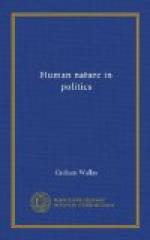Even in thinking of the smallest subdivisions of observed political fact some men escape the temptation to ignore individual differences. I remember that the man who has perhaps done more than any one else in England to make a statistical basis for industrial legislation possible, once told me that he had been spending the whole day in classifying under a few heads thousands of ‘railway accidents,’ every one of which differed in its circumstances from any other; and that he felt like the bewildered porter in Punch, who had to arrange the subleties of nature according to the unsubtle tariff-schedule of his company. ‘Cats,’ he quoted the porter as saying, ’is dogs, and guinea-pigs is dogs, but this ‘ere tortoise is a hinsect.’
But it must constantly be remembered that quantitative thinking does not necessarily or even generally mean thinking in terms of numerical statistics. Number, which obliterates all distinction between the units numbered, is not the only, nor always even the most exact means of representing quantitative facts. A picture, for instance, may be sometimes nearer to quantitative truth, more easily remembered and more useful for purposes of argument and verification than a row of figures. The most exact quantitative political document that I ever saw was a set of photographs of all the women admitted into an inebriate home. The photographs demonstrated, more precisely than any record of approximate measurements could have done, the varying facts of physical and nervous structure. It would have been easily possible for a committee of medical men to have arranged the photographs in a series of increasing abnormality, and to have indicated the photograph of the ‘marginal’ woman in whose case, after allowing for considerations of expense, and for the desirability of encouraging individual responsibility, the State should undertake temporary or permanent control. And the record was one which no one who had ever seen it could forget.
The political thinker has indeed sometimes to imitate the cabinet-maker, who discards his most finely divided numerical rule for some kinds of specially delicate work, and trusts to his sense of touch for a quantitative estimation. The most exact estimation possible of a political problem may have been contrived when a group of men, differing in origin, education, and mental type, first establish an approximate agreement as to the probable results of a series of possible political alternatives involving, say, increasing or decreasing state interference, and then discover the point where their ‘liking’ turns into ‘disliking.’ Man is the measure of man, and he may still be using a quantitative process even though he chooses in each case that method of measurement which is least affected by the imperfection of his powers. But it is just in the cases where numerical calculation is impossible or unsuitable that the politician is likely to get most help by using consciously quantitative conceptions.




